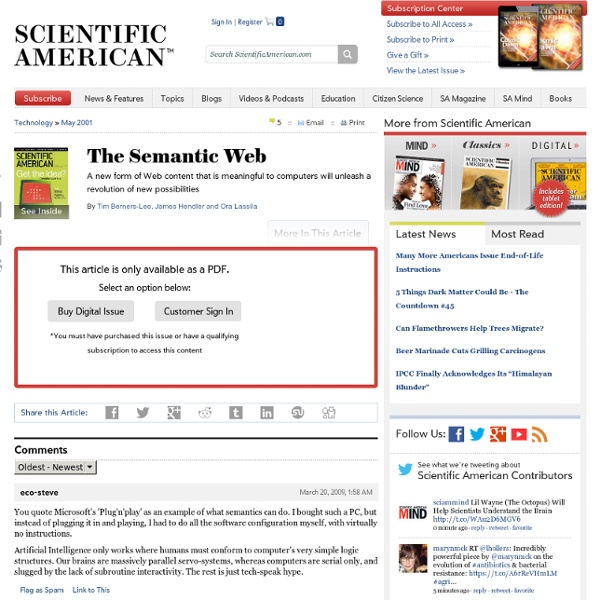



The Semantic Web: An Introduction This document is designed as being a simple but comprehensive introductory publication for anybody trying to get into the Semantic Web: from beginners through to long time hackers. Recommended pre-reading: the Semantic Web in Breadth. Table Of Contents What Is The Semantic Web? The Semantic Web is a mesh of information linked up in such a way as to be easily processable by machines, on a global scale. The Semantic Web was thought up by Tim Berners-Lee, inventor of the WWW, URIs, HTTP, and HTML. What's the rationale for such a system? So the Semantic Web can be seen as a huge engineering solution... but it is more than that. The Semantic Web is generally built on syntaxes which use URIs to represent data, usually in triples based structures: i.e. many triples of URI data that can be held in databases, or interchanged on the world Wide Web using a set of particular syntaxes developed especially for the task. URI - Uniform Resource Identifier RDF - Resource Description Framework Why RDF? Logic
Semantic Web The promise of web standards W3C standards define an open web platform for application development. The web has the unprecedented potential to enable developers to build rich interactive experiences, that can be available on any device. The platform continues to expand, but web users have long ago rallied around HTML as the cornerstone of the web. Many more technologies that W3C and its partners are creating extend the web and give it full strength, including CSS, SVG, WOFF, WebRTC, XML, and a growing variety of APIs. W3C Standards and Drafts Why W3C web standards? W3C publishes recommendations, that are considered web standards. W3C develops technical specifications according to the W3C Process, which is designed to maximize consensus, ensure quality, earn endorsement and adoption by W3C Members and the broader community. W3C web standards are optimized for interoperability, security, privacy, web accessibility, and internationalization. Wide array of applications
C Semantic Web Activity The Semantic Web is a web of data. There is lots of data we all use every day, and it is not part of the web. I can see my bank statements on the web, and my photographs, and I can see my appointments in a calendar. Why not? The Semantic Web is about two things. See also the activity news for an account of recent events, publications, etc. The following groups are part of the Semantic Web Activity. Active Groups Semantic Web Coordination Group The Semantic Web Coordination Group is tasked to provide a forum for managing the interrelationships and interdependencies among groups focusing on standards and technologies that relate to this goals of the Semantic Web Activity. RDFa Working Group The mission of the RDFa Working Group, formerly known as the W3C RDF Web Application Working Group, is to support the developing use of RDFa for embedding structured data in Web documents in general. RDF Working Group Linked Data Platform Working Group Semantic Web Interest Group Past Groups OWL Working Group